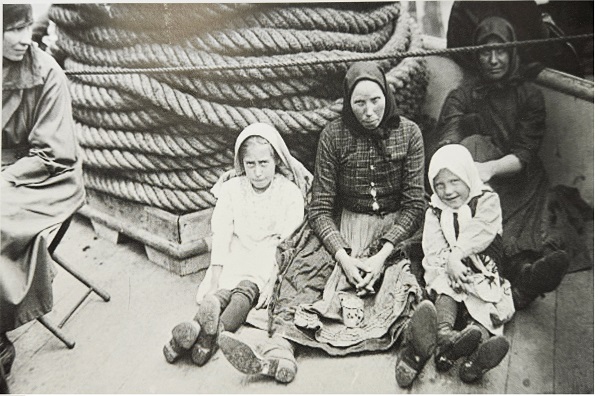Sixth chapter of the publication, in ten chapters both in Italian and English, of the academic presentation that our periodic collaborator Goffredo Palmerini held in L’Aquila on November 3rd, on the occasion of the CRAM Assembly (Regional Council of Abruzzesi in the World). The report is entitled “Historical notes on Italian emigration” and traces the history of the Italian Diaspora.
L’AQUILA – (continued… part six) Bringing together 140 million Italians who have the same cultural roots (60 within the borders, 80 abroad – and according to Piero Bassetti there should also be another 110 million “Italians” to be considered in calculus) is a public policy challenge that the Italy must ultimately face. Add that to the policies to promote the Italian language and culture abroad, towards which Italy does little as it allocates insufficient resources for this purpose.
Nonetheless, Italian is today the fourth most studied language in the world.
Those who study the Italian language, even if they are not Italian, do so because they love Italy, they love Italian culture, they love Italian taste, they love Italian style, they love the Italian way of life. The attention to our culture is extraordinary. We Italians ourselves are sometimes unaware of the enormous intellectual, cultural and artistic heritage of our Italy – almost two thirds of the world’s total. The dimension of what we are and what we represent for the entire world, in terms of artistic and cultural heritage, eludes our grasp.
Let us go back, to reflect in greater detail, the migratory routes that were followed in the first emigration (1861-1940), and especially after 1945 with the second emigration. As I mentioned before, the routes of the first major emigration headed towards the United States and the countries of South America, first and foremost Brazil and Argentina, but also Uruguay and Chile.
After the Second World War, in addition to the just mentioned preemptions towards the Americas, destinations such as Canada and Venezuela became more popular, as also the new destination – Australia. Then there is the massive emigration radiating throughout the “Old World” (Europe), starting from France, to Switzerland, to Belgium – especially in the coal mines thanks to the Italian/Belgian treaty; to Germany, by then in full reconstruction and strong industrial redevelopment.
We need to consider some figures on emigration, just to give an idea without the pedantry of statistical data that would make this conversation long and burdensome. Some essential numbers are important to better understand the topic of Italian emigration over a period of approximately 150 years. In that context, we should note that the most significant emigration, in absolute terms – even if sometimes this does not appear so – was that towards Brazil, the country which has the largest presence of Italians in absolute terms: around 25 million.
The other country with a large Italian community is Argentina. The number of Argentines with Italian origins is notable. In percentage terms (not absolute, which remains Brazil) Argentina is the country that has the highest percentage of Italians, approximately half of the inhabitants of Argentina, almost 22 million. Without any hint of condescension, there is a reason for the choice of Argentina by those who at the time left with ships from Italy. Consider the “sophistication” and level of education that the Italian population had at the end of the 19th century and the beginning of the 20th century.
Consider as well that those who left in the first emigration had little, if any, scholastic or professional preparation. They did not know grammatical skills, much less the rudiments of scientific knowledge. They were almost all agricultural workers; a smattering were artisans. For those who were about to leave a land as sharecroppers, day labourers or with land barely sufficient to support their family, the attraction of those places where they might become landowners of property enough to provide for their ever-growing numbers will have appeared as a dream within reach in their lifetime.
Thus, the dream was to go to these new lands of Latin America and acquire plots of land available they could consider as their own, maybe even be legal owners. There were specific policies, for example in Brazil, according to which immigrants were given ownership of a large plot of land in remote and almost deserted places. There, communities of farmers, entire villages, were formed thanks to our emigrants.
The case of Pedrinhas Paulista, in Brazil, comes to mind, where a group of Abruzzo emigrants established a colony and a very cohesive community after the Second World War. In Argentina, in particular, something similar happened in the endless extension of the Pampas. Those lands were important for the first Italian emigration, not only for livestock breeding, but also for the intensive cultivation of cereals and other crops. Many Italians left for Argentina in the years before the First World War.
(continues…)
Translation in English by the Hon. Joe Volpe, Publisher
In the pic above, historic meeting between Italians in Italy and Italian emigrants: from left, some of the Team Canada deputies visiting L’Aquila on May 22, 1998: Carmine Provenzano, Joe Volpe (Deputy Minister of Health of Canada at the time), Aline Cretien, Gary Pillitteri , Karen Redmond, Maria Minna, Prime Minister Jean Cretien (at the time Prime Minister of Canada) and Goffredo Palmerini (Deputy Mayor of L’Aquila at the time); the pic at the top of the article is “Sul molo” from the book “La Merica. Emigrazione dei Monteleonesi verso gli Stati Uniti dal 1882 al 1924” by Antonio De Vitto






